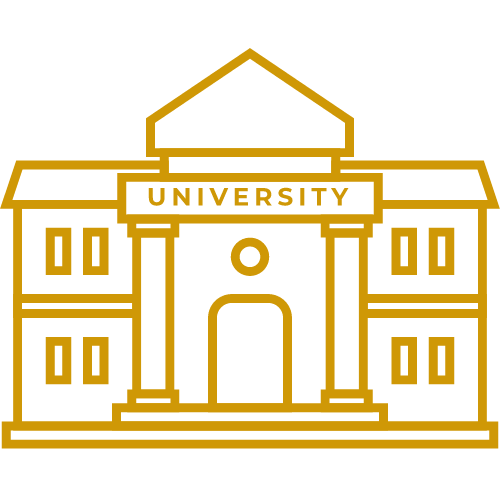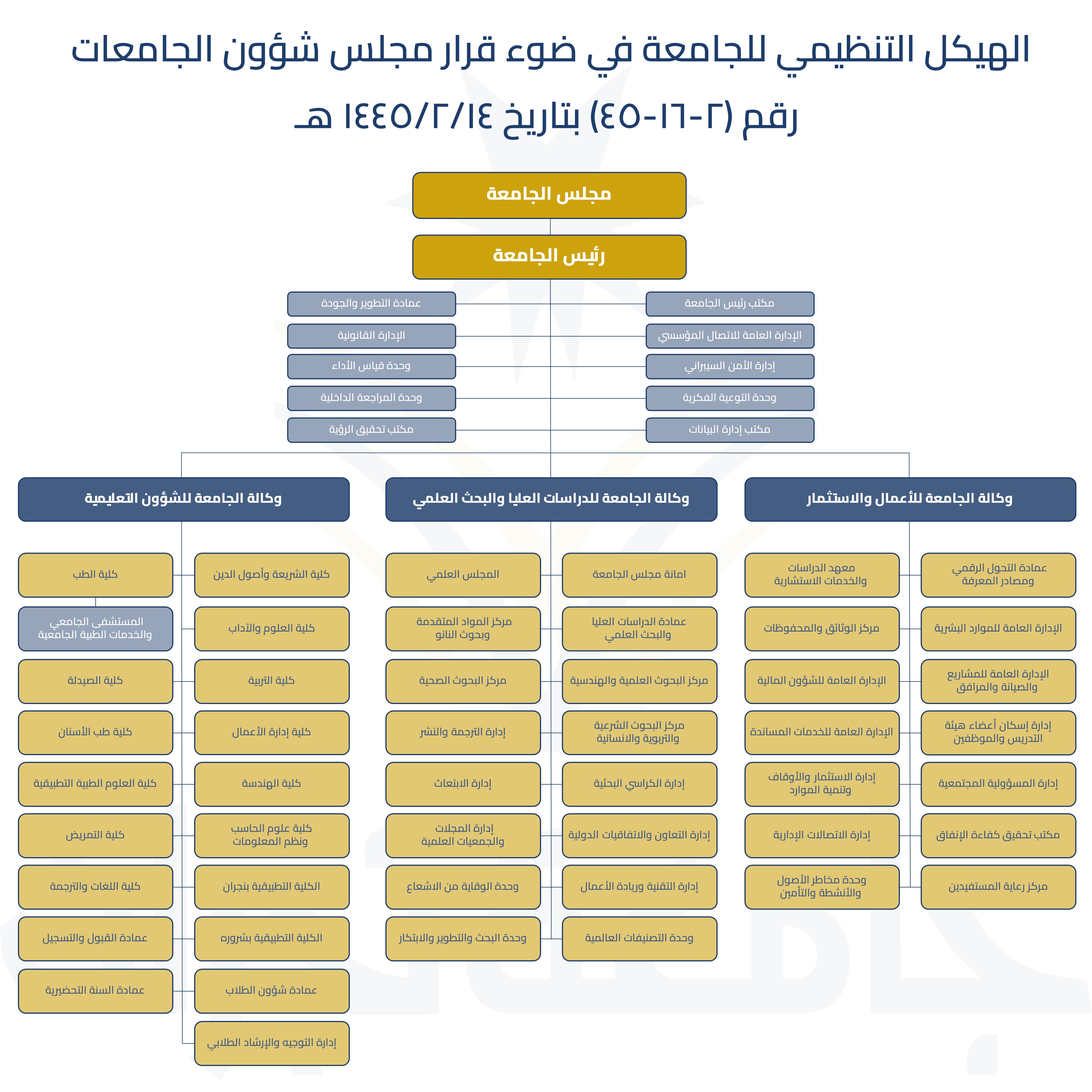About NU
![]() The University Esatablishment:
The University Esatablishment:
The custodian of the Two Holy Mosques King Abdullah Bin Abdulaziz, may Allah bless him, issued a royal decree of establishing Najran University on Shawaal 10th,1427A.H. during the inauguration ceremony of the University campus.
![]() The University Location:
The University Location:
Najran University is located on the Eastern outskirts of the city of Najran, with an area of 18 million square meters, thus becoming the largest University campus all over the Kingdom. The University will include two campuses for males and females. It consist of 15 and 10 colleges for males and females respectively, with an overall capacity of 45 thousand students. The university will also have a medical city, a research center, a sport and entertainment arenas and accommodation for the faculty and staff members as well as students. There will also be a future investment city to serve as a trust foundation for the university. The investment will include, not exclusively, hotels, commercial centers and private schools.
 The University Colleges:
The University Colleges:
The University comprises at the moment fourteen colleges, as follows:
College of Applied Medical Sciences
Grants BS degrees and consists of the following departments:
-Department of Clinical Laboratories Sciences
-Department of Radiology Sciences
-Department of Natural Therapy
College of Computer Science and Information Technology
Grants BS degrees and consists of the following departments:
-Department of Computer Science
-Department of Information Technology
-Department of Network Engineering and Telecommunications
College of Engineering
Grants BS degrees and consists of the following departments:
-Department of Mechanical Engineering
-Department of Industrial Engineering
-Department of Electrical Engineering
-Department of Civil Engineering
-Department of Chemical Engineering
-Department of Architectural
Engineering
College of Languages
Grants BA degrees and consists of the following departments:
-Department of English Language
-Department of Translation
College of Dentistry
Grants BS degrees and consists of the following departments:
-Department of Preventive Dental
Sciences
-Department of Restorative Dental
Sciences
-Department of Prosthetic Dental
-Department of Maxillofacial Surgery
& Diagnostic Sciences
College of Pharmacy
Grants BS degrees and consists of the following departments:
-Department of Pharmaceuticals
-Department of Clinical Pharmacy
-Department of Drugs
-Department of Pharmacology
-Department of Pharmaceutical
Chemistry
College of Nursing
A- Grants BA degrees:
-Department of Nursing
B-Department of Midwifery grants
diplomas degree in the following majors
-Department of Nursing Learning and
Administration.
-Nursing Depart of Surgical and Internal
Medicine.
-Nursing Depart of Mater and child
Health.
-Nursing Depart of Comm Health and
Mental Heal
College of Arts and Sciences
of Sharora
Grants BA degrees in the following majors:
A – Scientific Majors
- Department of Chemistry
- Department of Mathematics
- Department of Computer Sciences
B – Theoretical Departments:
- Department of Arabic Language
- Department of Islamic Studies
- Department of English Language
-Department of Education and
Kindergarten Education
College of Medicine
Grants BS degrees and consists of the following departments:
- Department of Surgery
- Department of Microbiology
- Department of Internal Medicine
- Department of Physiology
-Department of Family and
Community Medicine
- Department of Pediatrics
- Department of Pathology
-Department of Obstetrics and
Gynecology
- Department of Biochemistry
College of Administrative Sciences
Grants BA degrees and consists of the following departments:
-Department of Business Administration
-Department of Public Administration
-Department of Accountancy
-Department of Administrative
Information Systems
-Department of Systems
-Department of Marketing and
E-Commerce
College of Arts and Sciences
Grants BA degrees in the following majors:
A – Scientific Majors:
- Department of Mathematics
- Department of Physics
- Department of Chemistry
- Department of Biology
B – Humanities:
- Department of Arabic
- Department of English
College of Education
Grants BA degrees and consists of the following departments:
-Department of Education and
Psychology
-Department of Home Economics
-Department of Kindergarten Education
-Department of Special Education
-Department of Curriculum and
Instructions
College Applied
Grants University diplomas and consists of the following departments:
- Department of Computer Sciences
- Department of Medical Sciences
-Department of Administrative Sciences
College of Sharia and Fundamentals of Religion
Grants BA degrees in the following majors:
- Department of Sharia
-Department of Fundamentals of
Religion
 The University Deanships:
The University Deanships:
Deanship of Digital Transformation and Knowledge Resources
The Deanship of Student Affairs works to provide a suitable environment for educational attainment, practical training and character building, in which students invest their time inside and outside the university in religious, cultural and social activities in order to develop their talent in all aspects.
Deanship of Development and Quality
The Deanship of Development and Quality is responsible for monitoring and evaluating the management of comprehensive quality systems and continuous improvement across all academic, research, and administrative units. It provides the necessary technical support to ensure the university's vision, mission, and strategic goals are achieved.
Deanship of Admission and Registration
The Deanship of Admission and Registration is responsible for enrolling students who meet the university’s admission criteria and confirming their acceptance. It serves as the first gateway for students entering the university and the final step as they receive their diplomas and academic degrees.
Deanship of Student Affairs
The Deanship of Student Affairs works to provide a suitable environment for educational attainment, practical training and character building, in which students invest their time inside and outside the university in religious, cultural and social activities in order to develop their talent in all aspects.
Deanship of Preparatory Year
The Deanship of Preparatory Year provides a one-year program for most university students to prepare them for medical, scientific, and administrative specializations.
Deanship of Graduate Studies and Scientific Research
The Deanship of Graduate Studies and Scientific Research focuses on developing graduate programs and promoting scientific research by supporting researchers and providing an encouraging academic environment. It also fosters research partnerships and encourages scientific publications to achieve academic excellence.
 Vision
Vision
Leadership in teaching, learning and scientific research to build an innovative and internationally competitive knowledge society.
 Mission
Mission
Providing distinguished education and producing competitive scientific research that contribute to the development of the knowledge economy and building effective community partnerships, by strengthening institutional governance that supports creativity and national values.
 Values
Values
- Leadership: the science and art of guiding others towards achieving goals with the lowest costs and highest returns.
- Responsibility: Positive interaction towards the university and society based on a sense of nationalism.
- Honesty: faithfully performing tasks and fulfilling rights and duties.
- Transparency: Clarity in all duties and activities, decisions and transactions.
- Excellence: doing business in an elaborate and innovative manner.
- Moderation: moderation in all actions in thought and approach, and application of the constants, taking into account the surrounding variables.
- Creativity: supporting novelty , especially in ideas, with the use of what has been created in the form of a product.
- Empowerment: Providing opportunities for participation for all male and female employees of the university in decision-making.
- Affiliation: loyalty to the homeland and the promotion of its principles and values in the university's programs and activities.
- Integrity: Commitment to ethical and professional principles based on Islamic Sharia.
Vice Rectorate for Educational Affairs
Dr. Bandr Al Shehri
Vice Rectorate for Scientific Research
Dr. Huda Al Yami
Vice Presidency for Business and Investment
Dr. Youssef Al-Hazmi
